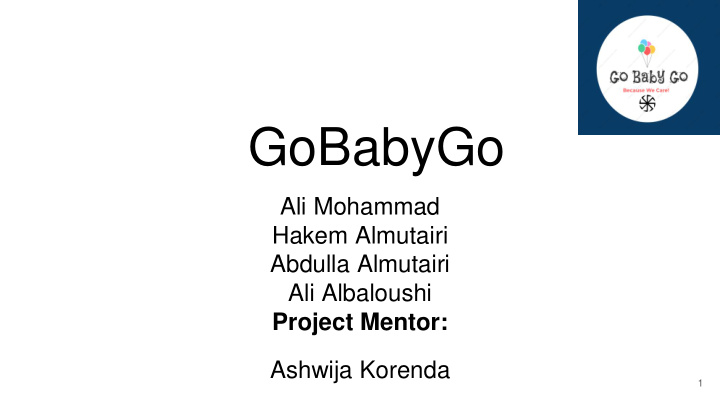



GoBabyGo Ali Mohammad Hakem Almutairi Abdulla Almutairi Ali Albaloushi Project Mentor: Ashwija Korenda 1
Overview: ● Introduction. ● Why this project was pursued and completed? ● Our clients and why it matters to them ● What was done? ● How it was done? ● End product ● Conclusion 2 Abdulla
Introduction: ● The GoBabyGo is an international movement to empower children with disabilities. ● Children with limited mobility often do not receive the much needed exposure of socialization. ● Existing research shows that enabling young children with self control of their own environment can have meaningful impacts. 3 Abdulla
Why this project was pursued and completed ● Project was pursued because it will allow kids with mobility issues to: ○ Socialize with friends and family. ○ Improve posture. ○ To reduce depression. ○ To explore their environment. ○ To make them kings/queens of their domain. ○ Lessen melancholy. Hakem 4
Clients: Dr. James Cole Galloway ● Professor, Dept. of Physical Therapy. ● University of Delaware. ● Founder of the project. Dr. Kyle Winfree ● Assistant Professor ● PhD,Biomechanics and Movement Science, University of Delaware. ● MSE,Robotics, University of Pennsylvania. ● BS,Physics, Northern Arizona University. Hakem 5
Why does it matter to our clients: ● They want to help families. ● Bringing joy to the child's life. ● Boosts the confidence of the children. ● Allowing the child to move independently. ● Allowing the children to explore their environment. ● They want children with mobility issues to be more social with their peers. 6 Ali Albaloushi
Client Needs & Family Needs: ● ● Client Needs: Family Needs: ○ ○ Kick the ball. Adjust the car so the child can ○ Simple. play kickball/soccer. ○ ○ Control the motor with a switch. Distribute the weight evenly on the car. ○ Make the seat comfortable. 7 Ali Albaloushi
Work Breakdown Structure(WBS): 8 Ali Mohammad
Work Breakdown Structure(WBS): 9 Ali Mohammad
Work Breakdown Structure(WBS): 10 Ali Mohammad
What was done: ● Inspiration : Function of a Pinball game; Use flippers in front of the wild car thing to kick the ball. 11 Ali Mohammad
What was done: ● Implementing the subsystems in the wild thing car ○ Switch: ■ Will sense the position of the flipper, thus it turning on/off. ■ DIY reciprocating motor & L298 H-Bridge ■ Will be connected on flippers. ■ H-Bridge will control the power sent to the motor. ○ Flippers: ■ To hit the ball. ● Worked as planned. 12 Ali Mohammad
What was done: ● Using the shovel and applying it on the wild thing car. ○ Plan A.1 ● Implementing the subsystems in the wild thing car ○ Switch: ■ Will give the signal thus turning on/off the motor. ○ DIY reciprocating motor & L298 H-Bridge ■ Connected on flippers. ■ H-Bridge will control the direction of the motor. ○ Shovel: ■ To hit the ball. ● Didn’t deliver required force to kick the ball. 13 Ali Mohammad
What was done: ● Back-up design ● Implementing the subsystems in the wild thing car ○ Brushless motor & Potentiometer: ■ Connected to the tires. ■ Potentiometer will control the speed of motor. ○ Tires: ■ Rotating to hit the ball. ● Was not able to kick as the size of the ball is bigger. 14 Ali Mohammad
Challenges: ● In terms of software: ○ Compiling error. ○ Uploading error. ○ Bugs in the code. ○ Implementation of Arduino Code. 15 Ali Mohammad
Challenges: ● In terms of hardware: ○ Loose structure. ○ Shorting out the circuit. ○ Wild thing car design it self. ○ Different screws to consider. ○ DIY Linear Motor configuration. ○ Momentary Switches attachment on on the wild thing. Hakem 16
How it was done? ● Software: ○ Arduino Microprocessor. ○ L298 H-Bridge 17 Ali Mohammad
How it was done? ● Hardware: ○ Metal Bars. ○ Screws and washers. ○ Flippers. ○ PVC pipes. ○ Punched Square tube zinc plated ○ Momentary-On Push Button Switch ○ DIY Recorperating motor Hakem 18
How it was done? ● Create the design. ● Electric saw: ○ Cut metal bars. ● Screws: ○ To tight all parts together. ○ To have a solid structure. ● Adjust the design of the wild thing car: ○ Pipes of the car itself. ○ Make space for the motors. ● Implementing momentary switches on the wild thing car: ○ Switch on controller. ○ Switch next to the motor. ● Wiring the circuit. Ali Albuloushi 19
Project Constraints: ● Clients imposed constraints: ○ Have to use the wild thing car. ○ Can’t use any other car in the lab. ● Hardware constraints: ○ Materials arriving late. ○ Not satisfying the purpose as expected. ● Budget Constraints: ○ 500$ dollars. ○ exceeding our budget. ● Not having enough equipment in the lab. ○ Went to Home Depot. Ali Albaloushi 20
End Product: 21 Ali Albuloushi
End Product: ● A brief video of using the wild thing car: Abdulla 22
Conclusion: ● Existing research shows that enabling young children with self control of their own environment can have meaningful impacts. ● The project was pursued to help support children with mobility issues. ● Inspiration : Function of a Pinball game; Use flippers in front of the wild car thing to kick the ball. ● We had multiple backup designs, but we went back to the original design which is the flippers idea. ● Challenges were dealt with and solved accordingly. Abdulla 23
Questions 24
Recommend
More recommend